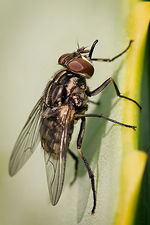Difference between revisions of "Stomoxys calcitrans"
(Created page with 'thumb|right|150px|''Stomoxys calcitrans'' - Wikimedia Commons *Also known as the stable fly *'''Visiting''' biting fly **Feeds on the host **Sp…') |
|||
| (28 intermediate revisions by 3 users not shown) | |||
| Line 1: | Line 1: | ||
| − | [[Image:Stomoxys calcitrans.jpg|thumb|right| | + | {{OpenPagesTop}} |
| − | + | {{Taxobox | |
| + | |name = Stomoxys calcitrans | ||
| + | |kingdom = | ||
| + | |phylum = | ||
| + | |class = [[Insecta]] | ||
| + | |sub-class = | ||
| + | |order = | ||
| + | |super-family = | ||
| + | |family = Muscidae | ||
| + | |sub-family = | ||
| + | |genus = | ||
| + | |species = | ||
| + | }} | ||
| + | [[Image:Stomoxys calcitrans.jpg|150px|thumb|right|'''Stomoxys calcitrans''' Fir0002/Flagstaffotos 2007, Wikimedia Commons]] | ||
| + | Also known as: '''''Stable fly | ||
| − | + | ==Introduction== | |
| − | + | ''S. calcitrans''are of the family ''Muscidae''. They can feed on a number of hosts in close succession, and therefore can act as an important mechanical vector in the transmission of disease e.g. [[Equine Infectious Anemia|Equine infectious anaemia]]. | |
| − | |||
| − | + | ''S. calcitrans'' can also act as intermediate hosts of the [[:Category:Nematodes|nematode]] ''[[Habronema]]''. | |
| − | + | ==Identification== | |
| + | ''Stomoxys calcitrans'' has a high resemblance to [[Musca spp.|''Musca domestica'']]. | ||
| + | ''S. calcitrans'' is 5-7mm long, and both the males and females suck blood. They are grey with four long longitudinal stripes on the thorax, and with large black spots on the abdomen. | ||
| + | The larvae are identified by examination of the posterior spiracles. | ||
| − | + | Eggs are yellow, and approximately 1mm in length. | |
| − | |||
| − | |||
| − | |||
| − | |||
| − | |||
| − | |||
| − | |||
| − | |||
| − | |||
| − | |||
| − | |||
| − | |||
| − | |||
| − | |||
| − | |||
==Life cycle== | ==Life cycle== | ||
| − | + | Eggs are laid on manure, or rotting hay and straw. The eggs then develop into larvae in usually less than 4 days, and then transform from larvae into adults. The females require several large blood meals before they are successfully able to reproduce. | |
| − | + | The life cycle from the production of an egg to a fully mature adult can range from 12-60 days. | |
| − | + | Adult flies can survive for around 1 month. | |
| − | + | {{Learning | |
| + | |literature search = [http://www.cabdirect.org/search.html?q=title:(%22Stomoxys+calcitrans%22) ''Stomoxys calcitrans'' publications] | ||
| + | }} | ||
| − | + | {{review}} | |
| − | |||
| − | |||
| − | |||
| − | |||
| − | + | {{OpenPages}} | |
| − | + | [[Category:Biting_Flies]] | |
| − | + | [[Category:Expert_Review]] | |
Latest revision as of 18:36, 18 July 2012
| Stomoxys calcitrans | |
|---|---|
| Class | Insecta |
| Family | Muscidae |
Also known as: Stable fly
Introduction
S. calcitransare of the family Muscidae. They can feed on a number of hosts in close succession, and therefore can act as an important mechanical vector in the transmission of disease e.g. Equine infectious anaemia.
S. calcitrans can also act as intermediate hosts of the nematode Habronema.
Identification
Stomoxys calcitrans has a high resemblance to Musca domestica. S. calcitrans is 5-7mm long, and both the males and females suck blood. They are grey with four long longitudinal stripes on the thorax, and with large black spots on the abdomen.
The larvae are identified by examination of the posterior spiracles.
Eggs are yellow, and approximately 1mm in length.
Life cycle
Eggs are laid on manure, or rotting hay and straw. The eggs then develop into larvae in usually less than 4 days, and then transform from larvae into adults. The females require several large blood meals before they are successfully able to reproduce.
The life cycle from the production of an egg to a fully mature adult can range from 12-60 days.
Adult flies can survive for around 1 month.
| Stomoxys calcitrans Learning Resources | |
|---|---|
 Search for recent publications via CAB Abstract (CABI log in required) |
Stomoxys calcitrans publications |
| This article has been peer reviewed but is awaiting expert review. If you would like to help with this, please see more information about expert reviewing. |
Error in widget FBRecommend: unable to write file /var/www/wikivet.net/extensions/Widgets/compiled_templates/wrt6933a686c20be9_78995291 Error in widget google+: unable to write file /var/www/wikivet.net/extensions/Widgets/compiled_templates/wrt6933a686c73973_60789087 Error in widget TwitterTweet: unable to write file /var/www/wikivet.net/extensions/Widgets/compiled_templates/wrt6933a686cc7cd0_50393712
|
| WikiVet® Introduction - Help WikiVet - Report a Problem |
